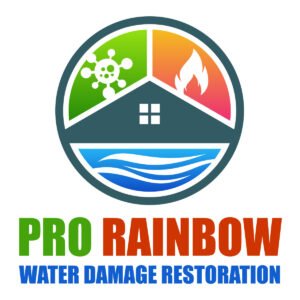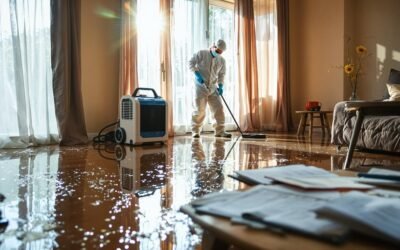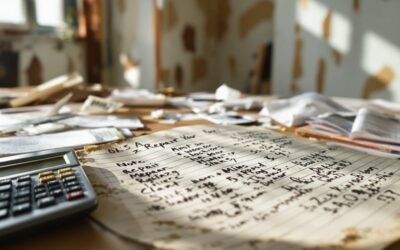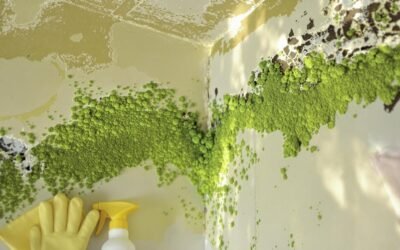When facing flood cleanup and water damage repair in Stockbridge, GA, start by identifying the type of water damage—be it clean, gray, or black water. Prioritize safety by wearing protective gear and shutting off electricity. Assess damage thoroughly, documenting it for insurance claims. Utilize effective extraction techniques like pumps and vacuums, followed by dehumidification and cleaning with eco-friendly products. Consider hiring certified professionals for complex situations. Don't forget preventive measures for future incidents. Understanding these steps guarantees a successful recovery. Stay tuned to uncover in-depth strategies and resources for a seamless restoration process.
Key Takeaways
- Assess the water damage category to determine the necessary cleanup and repair strategies for effective recovery.
- Ensure personal safety by using appropriate PPE and confirming electrical safety before beginning cleanup efforts.
- Utilize advanced extraction and drying techniques to promptly remove moisture and prevent mold growth during the cleanup process.
- Document all damages and repairs meticulously to support any insurance claims for water damage restoration.
- Engage local community resources and professionals with experience in flood recovery to enhance the restoration process.
Understanding Water Damage Types
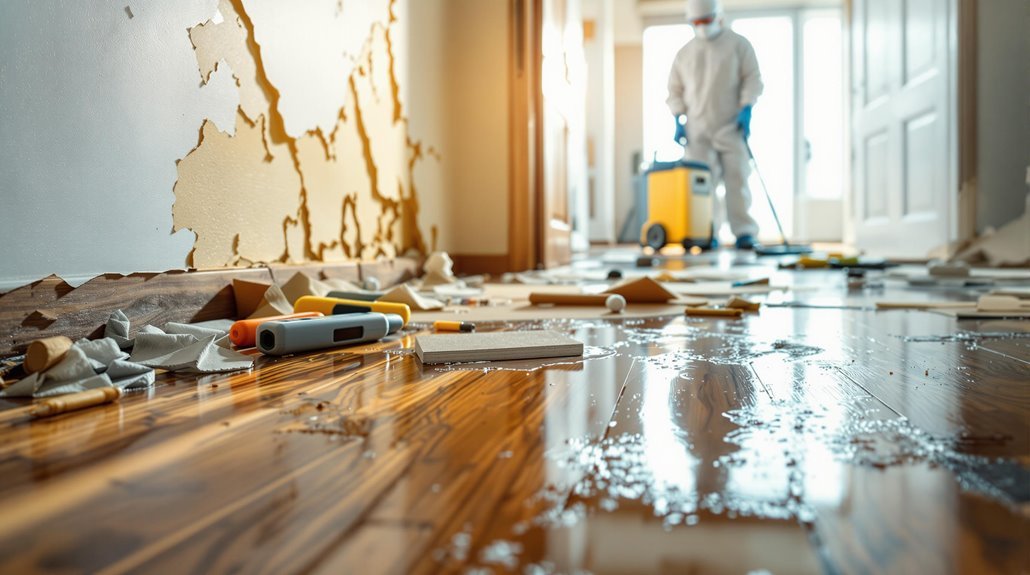
When you encounter water damage, it's crucial to understand the different types that can affect your property. Flood categories are critical for damage evaluation, as they categorize water based on its origin and contamination level. Category 1 includes clean water from sources like a broken pipe, posing minimal risk. Category 2 involves gray water, which may contain contaminants, often from appliances or sinks. Finally, Category 3 denotes black water, highly contaminated water from sewage or flooding, requiring immediate attention. Evaluating the damage involves identifying the category and extent of the water intrusion, which helps determine the necessary remediation processes. Understanding these categories guarantees you effectively address the specific water damage your property has sustained. Additionally, swift action is essential to minimize damage and ensure thorough professional restoration of your property.
Initial Safety Precautions
Before starting any cleanup, you need to assess the structural integrity of your property to guarantee it's safe to enter. Equip yourself with proper personal protective equipment, such as gloves and masks, to shield against contaminants. Furthermore, conduct thorough electrical safety checks to prevent hazards from damaged wiring or appliances. Additionally, it's crucial to prevent additional property damage by initiating emergency water removal as soon as possible.
Assessing Structural Integrity
Although evaluating structural integrity may appear intimidating, taking initial safety precautions is vital to guarantee your well-being. Start by conducting a thorough foundation evaluation. Look for visible cracks, settling, or any signs of movement that could indicate instability. Next, perform a load bearing assessment; check the walls, beams, and columns for any signs of bowing or sagging. Verify that these elements can support the structure's weight, particularly after water damage. Avoid areas with significant structural compromise and document your findings for future reference. If you notice any severe issues, it's important to consult a qualified structural engineer. Prioritizing these evaluations can help prevent accidents and guarantee a safer recovery process as you proceed with flood cleanup.
Personal Protective Equipment
Personal protective equipment (PPE) is vital for ensuring your safety during flood cleanup and water damage repairs. When tackling such tasks, you should prioritize personal safety by using the appropriate equipment types. Start with waterproof gloves to protect your hands from contaminants. A mask or respirator is necessary to guard against inhaling mold spores or harmful particles. Wear safety goggles to shield your eyes from debris and splashes. Long boots or waders will keep your feet dry and protect against sharp objects. Moreover, consider using hard hats if there's a risk of falling debris. By equipping yourself with the right PPE, you greatly reduce your risk of injury or illness while managing flood damage cleanup effectively.
Electrical Safety Checks
As you begin the flood cleanup process, conducting thorough electrical safety checks is essential to prevent potential hazards. First, confirm the power is turned off at the main circuit breaker before entering flooded areas. This simple step can greatly reduce electrical hazards. Next, inspect all electrical outlets, cords, and appliances for damage. If any are submerged or show signs of corrosion, do not use them until a qualified electrician has assessed the situation. Practice safe practices by using battery-operated lights instead of extension cords, which could pose risks in damp environments. Finally, consider hiring a professional to inspect the electrical system after the cleanup to verify everything is safe and functional. Your safety should always come first during these challenging times.
Assessing the Damage
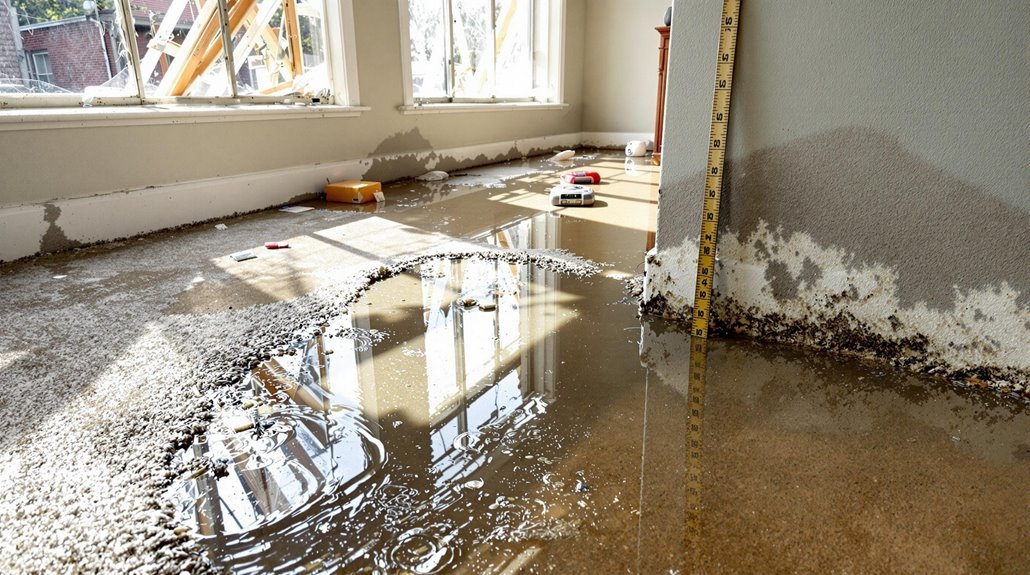
When you begin evaluating the damage after a flood, it's crucial to prioritize safety and gather the necessary tools for a thorough examination. Start with an assessment checklist to systematically document affected areas. Focus on visible damage, such as warped floors, stained walls, and damaged furniture. Check for hidden issues like mold growth or compromised structural integrity, especially in crawl spaces and basements. Use a moisture meter to assess humidity levels in walls and flooring, as excessive moisture can lead to long-term problems. Verify to record all findings meticulously, noting the severity and potential impacts on your home. This detailed damage evaluation will help you understand the extent of repairs needed and guide your next steps in the recovery process.
Documenting for Insurance Claims
After evaluating the damage, it's time to document everything for your insurance claims. Good insurance documentation is essential for a successful claim process. Start by taking clear photos of affected areas and items, ensuring you capture damages from multiple angles. Make a list of damaged belongings, including their age and value.
| Item Description | Estimated Value |
|---|---|
| Sofa | $500 |
| Electronics | $1,200 |
| Carpeting | $800 |
Keep receipts for any repairs or replacements you make. This thorough documentation will support your case and expedite your claim. Remember, the more detailed your records, the better your chances of receiving a fair settlement from your insurance provider.
Water Extraction Techniques
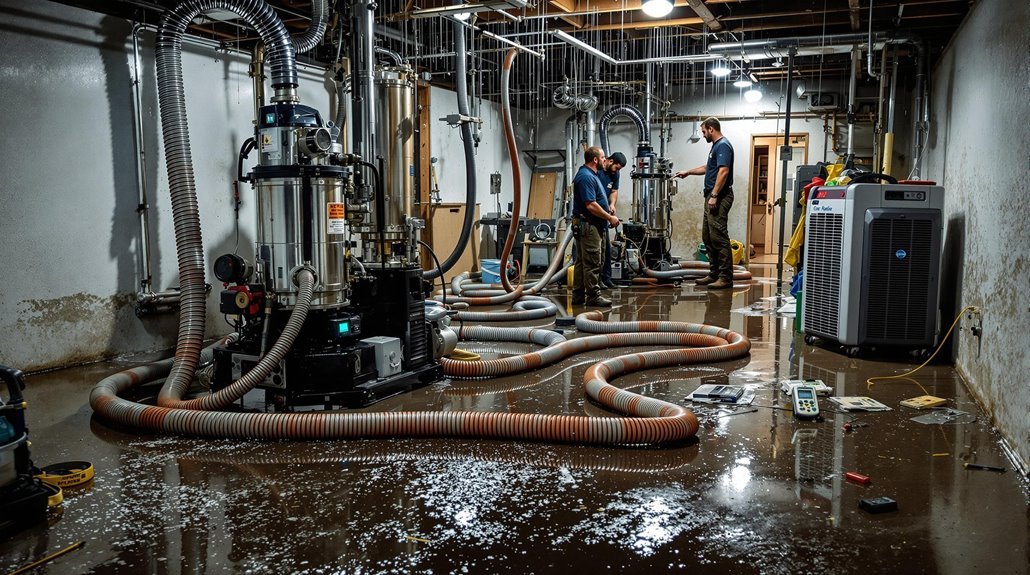
Effective water extraction techniques are crucial in mitigating further damage during flood cleanup. You'll want to assess the situation and choose the right equipment options for efficient water removal. Advanced extraction methods, such as truck-mounted pumps and portable extractors, can greatly speed up the process. Truck-mounted systems provide powerful suction, ideal for large areas, while portable units are perfect for confined spaces. Moreover, consider using wet/dry vacuums for smaller amounts of standing water. Remember to monitor moisture levels throughout the extraction process, as lingering water can lead to mold growth. By employing these advanced extraction techniques, you can effectively reduce the risk of secondary damage and create a safer environment for restoration efforts.
Drying and Dehumidification
Once you've removed excess water, drying and dehumidification become vital to prevent mold growth and structural damage. You'll need to employ effective techniques, such as using high-capacity dehumidifiers and fans, to guarantee thorough moisture removal. Regularly monitoring humidity levels during this process is fundamental to achieve ideal results and safeguard your property.
Importance of Drying
When water seeps into your home, the urgency of drying and dehumidification cannot be overstated. Effective drying techniques are vital for restoring your property and preventing further damage. By quickly removing moisture, you minimize the risk of mold growth and structural issues. It's important to assess the affected areas to determine the best approach for moisture control. This may involve using high-powered fans, dehumidifiers, and even thermal imaging to locate hidden damp spots. Remember that simply removing standing water isn't enough; you must guarantee that all surfaces, including walls and floors, are thoroughly dried. Taking these steps promptly can save you time, money, and stress in the long run, assuring a safer environment for you and your family.
Dehumidification Techniques
Dehumidification techniques play a crucial role in restoring a water-damaged environment. Effective humidity control prevents further damage, mold growth, and promotes faster recovery. Here are three key dehumidification methods you can use:
- Refrigerant Dehumidifiers: These machines cool the air, condensing moisture into water, which you can then drain away.
- Desiccant Dehumidifiers: Utilizing materials that absorb moisture, these devices work well in lower temperatures and are energy-efficient.
- Ventilation: Open windows and use fans to improve air circulation, helping moisture evaporate more quickly.
Monitoring Humidity Levels
How can you guarantee your space is drying effectively after a flood? Effective humidity monitoring is vital in this process. By using a hygrometer, you can track humidity levels, ensuring they remain within a safe range—ideally between 30% and 50%. If humidity levels are too high, it can lead to mold growth and further damage.
Implementing moisture control measures, such as dehumidifiers, can help speed up drying. Regularly check the devices to confirm they're functioning correctly. Furthermore, ventilate the area by opening windows or using fans. This combination of humidity monitoring and active moisture control will greatly improve your flood recovery efforts, ensuring your home dries thoroughly and safely.
Mold Prevention Strategies
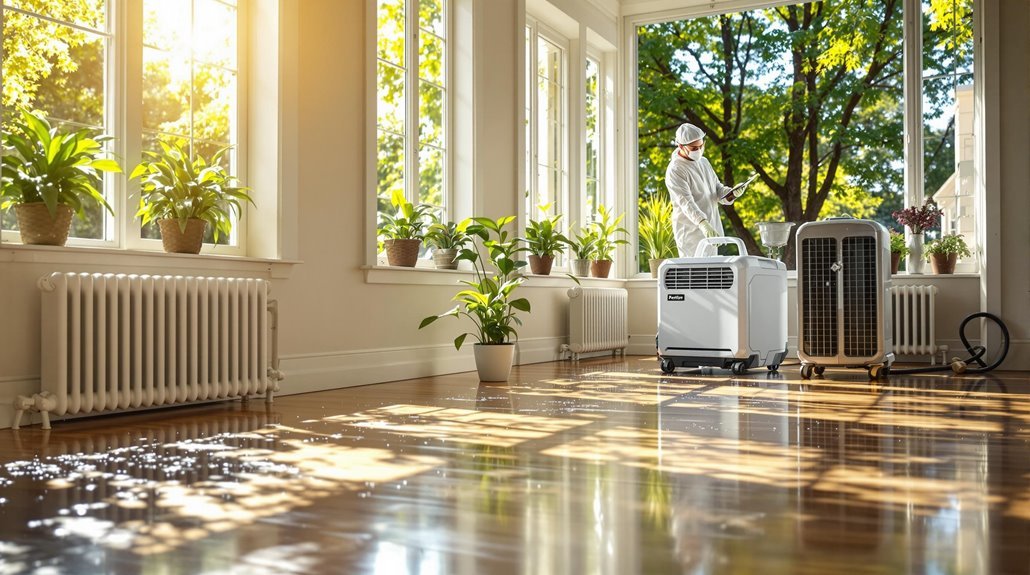
Although mold can quickly take hold in damp environments, implementing effective prevention strategies can greatly reduce your risk. Focus on moisture control by following these steps:
- Seal leaks: Regularly inspect your home for leaks in roofs, walls, and plumbing. Promptly repair any leaks to prevent moisture accumulation.
- Ventilate spaces: Guarantee proper airflow in areas prone to moisture, such as bathrooms and kitchens. Use exhaust fans and open windows to keep humidity levels low.
- Use dehumidifiers: Invest in dehumidifiers for consistently damp areas. Maintaining humidity below 60% will considerably inhibit mold growth.
Repairing Structural Damage
As water damage compromises the integrity of your home's structure, addressing repairs promptly is vital to guarantee safety and longevity. Start with thorough structural assessments to identify weakened areas, such as beams, joists, and foundations. Look for signs of warping, mold growth, or rust, as these indicate deeper issues. Once you've pinpointed damage, implement appropriate repair techniques; this might involve replacing compromised wood, reinforcing foundations, or using steel brackets for additional support. Ascertain the materials used match your home's original construction to maintain stability. It's important to consult professionals if the damage is extensive, as they can provide expert insights and assure compliance with building codes. Taking these steps will secure your home against future water-related problems.
Cleaning and Sanitizing
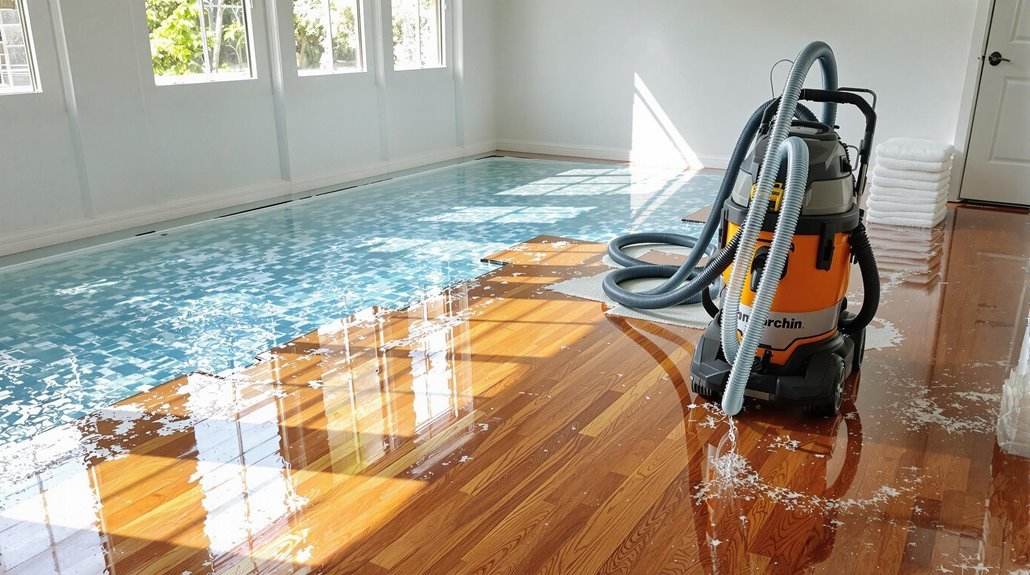
After addressing structural damage, it's essential to focus on cleaning and sanitizing the affected areas to prevent health risks. You'll need to use effective cleaning products that eliminate contaminants and guarantee all surfaces are thoroughly sanitized. Following specific steps will improve your cleaning process, making it more efficient and effective.
Importance of Sanitizing Surfaces
While flooding can cause extensive damage, the significance of sanitizing surfaces afterward cannot be overstated. Proper sanitization is essential for preventing illness and ensuring a safe environment. Here are three key reasons to prioritize sanitizing:
- Eliminate Pathogens: Floodwaters can introduce harmful bacteria and viruses. Using effective sanitizing techniques can neutralize these threats.
- Protect Surface Materials: Different materials react uniquely to water exposure. Proper sanitization helps maintain the integrity of wood, drywall, or metal, preventing long-term damage.
- Promote Health: A clean, sanitized space reduces the risk of mold growth and respiratory issues, safeguarding your health and well-being.
Recommended Cleaning Products
Choosing the right cleaning products is vital for effective flood cleanup and sanitizing. Start with eco-friendly cleaners that are safe for both your health and the environment. These products often contain natural ingredients, making them less harmful while still providing good cleaning power. For tougher areas affected by mold or bacteria, consider using industrial disinfectants. These powerful solutions effectively eliminate pathogens and can penetrate surfaces to guarantee thorough sanitization. Make certain to follow the manufacturer's guidelines for application and dilution. A combination of eco-friendly cleaners for general cleaning and industrial disinfectants for high-risk areas can provide a balanced approach, confirming your space is not only clean but likewise safe for you and your family.
Steps for Effective Cleaning
To guarantee a thorough cleaning and sanitizing process after a flood, it's essential to begin by evaluating the affected areas. This initial assessment aids in determining the extent of water damage and necessary flood preparedness measures. Follow these steps for effective cleaning:
- Remove standing water: Use pumps or wet vacuums to eliminate excess water quickly, allowing for better water mitigation.
- Clean surfaces: Disinfect walls, floors, and furniture using appropriate cleaning products. Focus on porous materials, as they can harbor mold.
- Dry everything: Make certain all items and spaces are completely dry to prevent mold growth and further damage.
Choosing Professional Services
How can you guarantee you're selecting the right professionals for flood cleanup and water damage repair? Start by focusing on service selection; look for companies with specialized experience in water damage restoration. Check contractor qualifications, including certifications from recognized organizations like the Institute of Inspection, Cleaning and Restoration Certification (IICRC). Assess their track record through online reviews and testimonials, which often reveal their reliability and quality of work. Furthermore, inquire about their methods and equipment. A reputable service provider should use advanced technology for moisture detection and remediation. Finally, ascertain they offer a detailed written estimate and a clear timeline for the project. This diligence will help you choose professionals who can effectively restore your property.
Preventative Measures for Future Flooding

After securing the right professionals for flood cleanup and water damage repair, it's important to implement preventative measures that can help mitigate future flooding risks. Here are three vital strategies to take into account:
- Rainwater Management: Verify your property is equipped with effective drainage systems to channel excess rainwater away from your home. Regular drainage system maintenance is significant.
- Flood Resistant Landscaping: Use native plants and design your yard to absorb rainwater. This can prevent runoff and reduce flooding risks.
- Emergency Preparedness Plans: Develop and educate your family on emergency plans, including sump pump installation and flood insurance education, to improve your readiness for potential floods.
Engaging in community awareness programs can likewise help promote a collective approach to flood prevention in your area.
Community Resources and Support
While maneuvering through the aftermath of a flood can be overwhelming, numerous community resources and support systems are available to help you recover and rebuild. Local resources, such as the Stockbridge Community Center, offer food assistance and temporary shelter during your recovery. Moreover, organizations like the American Red Cross provide financial aid, mental health support, and volunteer services to assist with cleanup efforts. Connecting with local churches and non-profits can likewise yield valuable community support, as many offer outreach programs aimed at helping flood victims. Don't hesitate to reach out to local government offices for information on disaster relief programs. By utilizing these resources, you'll find crucial support in your journey toward recovery and restoration.
Conclusion
To summarize, tackling flood cleanup and water damage repair isn't just a task; it's an epic battle against nature's fury! By understanding the types of damage, prioritizing safety, and documenting everything for insurance, you're setting yourself up for success. Don't hesitate to seek professional help when needed and implement preventative measures to safeguard your home. With the right knowledge and resources at your disposal, you can restore your space and protect it from future floods.
